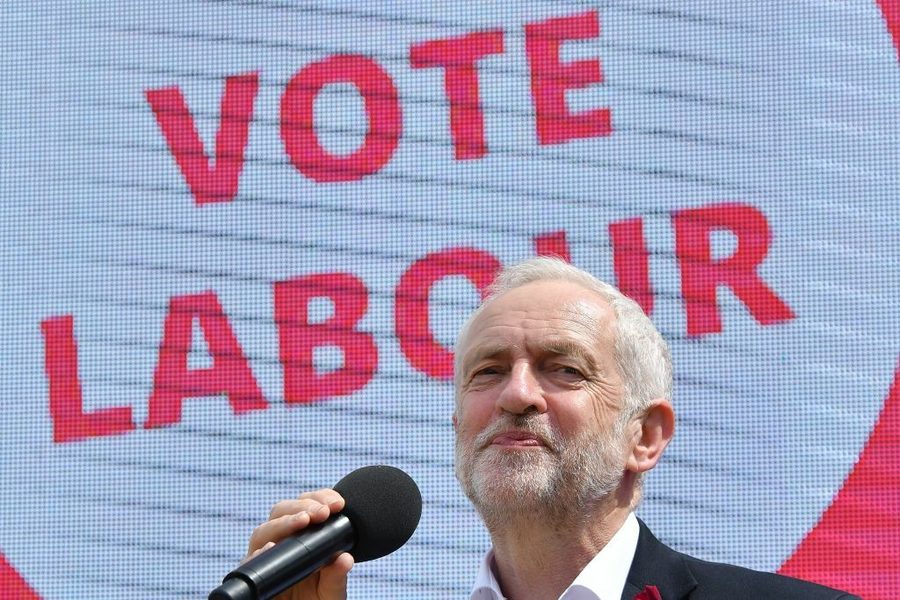Jeremy Corbyn and Labour May Just Upend British Politics from the Left
No matter the outcome, Corbyn has surprised his critics and built a stronger opposition.
Richard Seymour

Whatever Jeremy Corbyn has achieved in this election, he has done so against the odds.
Asked about his slim chances of being elected Prime Minister of Britain early in the 2017 campaign, he replied: “In 2015, almost exactly two years ago, I was given 200-1 as an outside chance.” And just early last month, polls showed his chances of winning looking similarly abysmal.
Today, just one day from the election, Labour is riding high. Some polls have put Corbyn’s party within a whisker of 40 percent of the vote. Even the least optimistic polls have Labour scoring in the mid-30s, suggesting a surprise improvement from the last general election two years ago.
The Conservatives are still the strong favorite to win. But how have Corbyn and Labour come this close? When this snap election was called in April, Labour was polling at close to a quarter of the vote, its lowest scoring in decades. Corbyn’s approval ratings were at rock bottom. The Conservatives were leading by 20 points, buoyed by support from former voters for UKIP — the hard-right party — following the Brexit vote.
The post-Brexit unification of the right-wing threatened to create conservative majorities in surprising places, turning former Labour heartlands over to the Tories.
Early in the race, some politicians from Labour’s right-wing — after trying to sabotage party leadership by essentially mounting a coup — attempted to throw the election by resigning or even calling for a vote against Corbyn. Many pundits questioned whether Corbyn had any chance of remaining leader of the party after the election.
The Tories, on the other hand, had a well-financed political machine headed by the PR strategist Lynton Crosby, an expert smear merchant. Crosby determined that the “wedge” issue most likely to split the Labour vote would be Corbyn’s past support for Irish republicanism, which the Tories construed in spin to the press and campaign ads as “links to the IRA.”
These attacks have been part of a larger strategy by the Tories to paint Corbyn as weak on national security. With two major terror attacks in the UK this election season, in Manchester and London, one might expect Labour to be running scared.
Not a bit of it. In response to the Manchester Arena massacre, carried out by a jihadi desperado punishing young people for enjoying themselves, it was Labour who expressed popular common sense. Perhaps in the past, the demand for violent retribution would have taken precedence. Corbyn’s support for Irish republicanism would have proved ruinous for his candidacy.
But the Good Friday agreement is nearly 20 years old, and few British voters are still susceptible to the old “Paddy Panic.” Those of us who grew up in the era of the “war on terror” knew it to be bloody and counterproductive.
Corbyn’s speech following the Manchester attack, critiquing the “war on terror,” improved his standing as a statesman. He railed against an unrestrained military response, calling instead for British politicians and voters to “be brave enough to admit the war on terror is simply not working.” Rather than being slammed in the polls, the speech was widely well-received, with 53 percent of the public agreeing with Corbyn and only 24 percent disagreeing.
Labour has also had a string of publicity successes, including Corbyn’s surprise, rapturously received appearance at a performance by the newly reformed rock group the Libertines at the Tranmere Rovers football stadium in Birkenhead.
In television appearances, he has come out looking much better than his opponent Theresa May. And Labour has been able to increase the party’s appeal to young voters by drawing the support of a string of grime artists — a popular music genre in the UK — and influential music magazines like NME and Kerrang!.
Perhaps most importantly, Labour’s manifesto has been instrumental in energizing supporters and converting undecided voters.
The manifesto, reportedly leaked by Corbyn’s opponents in Labour to sabotage his campaign, has been decisive in building support for the party. Polling has shown that its key policies, assailed by the press as “unrealistic,” are, in fact, extremely popular. These include:
- Re-nationalizing energy and rail services;
- Scrapping tuition fees and reintroducing maintenance grants for students, as part of a cradle-to-grave, free National Education Service;
- Addressing the housing crisis by building 100,000 affordable homes a year;
- Reversing privatization in the National Health Service;
- Raising the minimum wage to £10 an hour by 2020 and banning exploitative zero-hours contracts.
And Labour’s solution for paying for these investments? Taxing the rich and large corporations.
The language of “opportunity” and “aspiration” has long been associated with the Right. This neoliberal version of “aspiration” holds that the state only gets in the way of individual initiative concerning economic affairs.
But with younger generations being frozen out of the housing and labor markets, and students facing a privatized higher education system dominated by a British “Ivy League” scooping up the best resources, the language of aspiration no longer belongs to the Right.
For a growing number of Britons, our aspirations are collective, our opportunities dependent on democracy rather than the market. And this is a fundamental reason why Labour has gained momentum — by appealing to the collective rather than the individual.
Finally, the Conservative campaign has been abysmal. It has been impeded by May’s refusal to attend debates, her preference for offering robotic poll-tested catchphrases, rather than answers to questions, and her tendency to make policy decisions through a close-knit clique.
The policy of making the elderly pay for their own social care through the sale of their home, for example, was inserted into the Conservative manifesto by May and a small group of advisers. Its unpopularity forced an undignified U-turn for her campaign.
Corbyn, as a social democrat steeped in activism, has displayed previously hidden strengths through this campaign, connecting with voters in a way few pundits thought possible mere weeks ago. May’s weaknesses, previously buffered by a friendly Tory press, have in turn become much more pronounced.
The situation still favors a Conservative win. Post-Brexit realignment, the fear of the unfamiliar among swing voters and a low turnout among Labour supporters would likely point toward a majority for May.
But after this campaign, only a fool would rule out an impressive showing by Labour. Even if the party falls behind, as most polls predict, by driving up Labour’s vote with a strong left-wing campaign, Corbyn will have surprised his critics and built a stronger opposition ready for future success. And that is already a tremendous achievement.

I hope you found this article important. Before you leave, I want to ask you to consider supporting our work with a donation. In These Times needs readers like you to help sustain our mission. We don’t depend on—or want—corporate advertising or deep-pocketed billionaires to fund our journalism. We’re supported by you, the reader, so we can focus on covering the issues that matter most to the progressive movement without fear or compromise.
Our work isn’t hidden behind a paywall because of people like you who support our journalism. We want to keep it that way. If you value the work we do and the movements we cover, please consider donating to In These Times.






